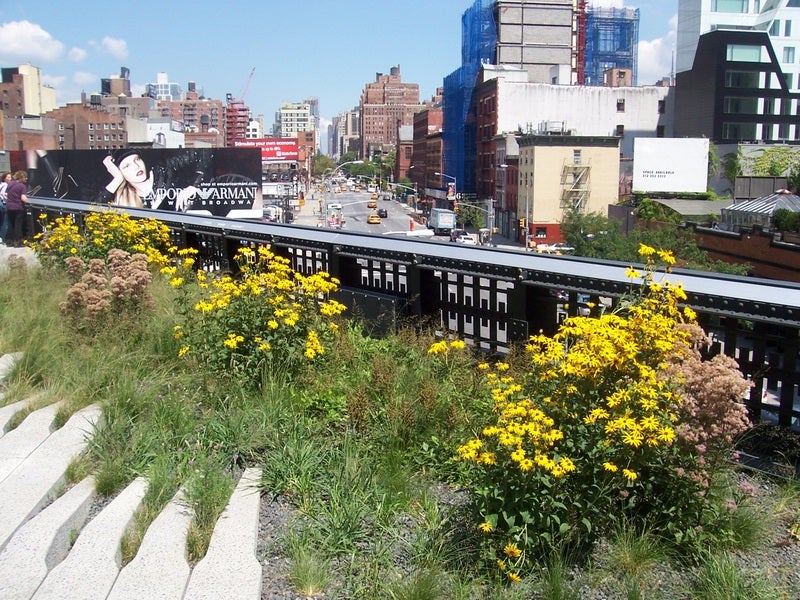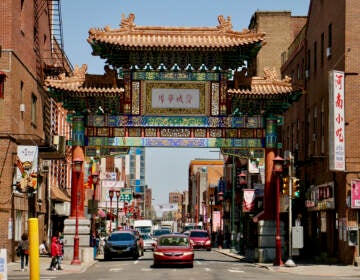From quandary to utopia

The High Line in NYC
Sept. 2, 2009
Read about our own Reading Viaduct
By Thomas J. Walsh
For PlanPhilly
An “urban-planning Rorschach.” We wish we had thought of it first, regarding the re-do of Penn’s Landing.
But here we’re referring to Nutten Island, a.k.a. Governors Island, a 172-acre anomaly in the mouth of New York Harbor profiled in the Aug. 31 issue of The New Yorker by writer Nick Paumgarten. First settled, like Manhattan, by the Dutch – in fact, its settlement preceded Manhattan’s – the federal government sold it back to New York State in 2003 for $1. (Of course, it was not that simple. Strings attached? More like financial lariats, such as a deed restriction banning residential development. Huh?)
Since 1997, when the last tenant, the Coast Guard, departed, “years of lethargy, caprice and bureaucratic swordplay” has rendered Governors Island “the city’s longest-lasting quandary” with no viable plan, “an urban-planning Rorschach, as various constituencies projected onto it their vision of what a city is, or should be.”
From Paumgarten’s fascinating account, it sounds less like our Petty’s Island than our Navy Yard, with its former off-limits-to-the-public nature, its stately old residences, ghost town ambiance, military bearing and location at the foot of the city between two rivers. It is a seven-minute ferry ride from the South Street Seaport or from Brooklyn – about the same amount of time it would take you to drive from Washington Avenue straight down Broad and into the Navy Yard.
The Navy Yard (check out our coverage) is not an island, of course, but like Governors Island, not many city residents know about it, much less set foot on its grounds. The other crucial difference, a fact that still seems beyond the imaginations of most Philadelphians, is that the Navy Yard is enormous – at 1,200 acres, it is the size of Center City. (Stop me if I’ve told you this before, with an incredulous tone of voice.)
Also, the Navy Yard is being redeveloped as we speak, with solid companies slowly taking up large parcels, in old refurbished brick barracks or new office buildings. Tasty Baking’s new HQ and manufacturing plant are there, and ships are being built at the Aker yard. The Navy even still has a presence, along with the occasional filmmaker in a converted hangar bay. But big swaths of land – several Governors Islands’ worth – lay fallow still.
Governors Island is gaining in visitors, playing the artsiest game of miniature golf you’ll find anywhere, biking around the perimeter of the island, lazing in hammocks, or hanging out in a new, smartly appointed new park where dilapidated military housing once stood. But because of state and city budgetary and funding problems (sounds familiar), it is actually still in danger of being closed again to the public.
The good news is that a Dutch architecture firm called West 8 (yes, Dutch) has completed a master plan for a 40-acre park on the southern part of the island, with “undulating asymmetric hills,” which would provide spectacular views – “entirely unfamiliar and thrilling” and “virtually San Franciscan.”
‘The fetishizing of decay’
Paumgarten has some interesting things to say about the designs in waiting, and the zeitgeist marrying green ambition with urban re-use, “the kinds that involve the clever transformation of dilapidated postindustrial wastelands or garbage dumps into useful and conscience-easing recreational space.”
“These are often, above all, artistic statements, celebrated by right-thinking urbanists,” he writes. “This sort of utopianism is in vogue in New York now. It’s a nexus of arty cosmopolitanism, environmentalism, and transportation geekery – a yearning we have to be Copenhagen, or Berlin. Or Amsterdam.”
You kind of get the feeling where he’s going with this, and on the next page, there it is: more chin-scratching about the High Line in Chelsea, the “clandestine aerie” turned hip park-in-the-sky, drawing big crowds since opening in June (see PlanPhilly’s photos attached, from a mid-August visit). Paumgarten writes of the High Line:
“It is a strange and beautiful place, an architectural marvel, simultaneously rugged and delicate. It was also a fashionable cause, financed in large part by the donations of rich people who had discovered the pleasure of urban ruin, and of altered perspective.
“There is something decadent about the formal curation of rust and the fetishizing of decay. The movement brings to mind the landed gentry’s enthusiasm, in England two centuries ago, for constructing phony Roman or Greek ruins, or ‘follies,’ on their estates.
“The risk of a project like the High Line, or Governors Island, is that the place may pass from one kind of elitism, in which virtually nobody is allowed, except those who have secret or privileged access, to another, in which ambitious restoration introduces esoteric or refined tastes and uses. The park plan, as it stands, looks a little like a park for cool people.”
You’ll have to buy or borrow a copy of the Aug. 31 New Yorker to read the whole article – it is only abstracted on the magazine’s Web site. But check out the great 4-minute video they produced, which illustrates well the potential of the island: http://www.newyorker.com/online/blogs/newsdesk/2009/08/video-tour-governors-island.html.
Contact the reporter at www.ThomasJWalsh.info.
WHYY is your source for fact-based, in-depth journalism and information. As a nonprofit organization, we rely on financial support from readers like you. Please give today.






